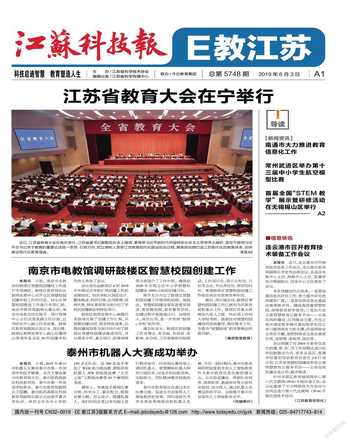CHARTING A COURSE FOR SUCCESS: AMERICA’S STRATEGY FOR STEM EDUCATION(Ⅳ)
【譯題】制定成功之路:美國STEM教育戰(zhàn)略(四)
Product of the COMMITTEE ON STEM EDUCATION of the NATIONAL SCIENCE & TECHNOLOGY COUNCIL
美國國家科學(xué)技術(shù)委員會STEM教育委員會
The most transformative discoveries and innovations take place at the junctures where disciplines converge. Discovery and innovation will be catalyzed by an education system that integrates knowledge and methods across STEM, the arts, and the humanities and requires students to ask and answer questions crossing traditional disciplinary boundary lines.
There are three objectives under this pathway:
Advance Innovation and Entrepreneurship Education
Innovation generally depends on a convergence of ideas at the intersection of different fields and sectors to produce new products or processes. In an increasingly competitive global economy, STEM education that emphasizes convergent processes and promotes problem-finding and creativity is needed to accelerate innovation and entrepreneurship. Education in these critical skills should play a larger role in STEM courses for learners from all demographics and communities to provide a pathway for more Americans to contribute to the Nation’s dynamic economy.
Key Federal actions needed to achieve this objective include:
·Review participation rates in federally funded competitions, challenges, and citizen science projects and apply best practices to attract a more diverse and inclusive community of participants where needed.
·Within Federal education and entrepreneurship investments, include support for activities that teach educators effective methods for making entrepreneurship education more inclusive and increasing the participation of underrepresented groups.
·Within Federal education and entrepreneurship investments, include support for activities that teach educators about the creation as well as the protection of intellectual property.
Make Mathematics a Magnet
Mathematics and statistics are foundational to success across all STEM fields of study, providing a universal language to describe and reason about models of real-world phenomena.
Mathematics continues to serve as a gateway to STEM majors that leads to higher-paying jobs and economic mobility. For the United States to produce a vibrant, diverse wave of talent for the future of STEM, mathematics must foster interest in and enthusiasm for science, technology, and engineering, drawing learners more deeply into these subjects—serving as a magnet, not a barrier, to further study.
Key Federal actions needed to achieve this objective include:
·Make Federal data more accessible for use in mathematics, statistics, and other STEM education courses, in user-friendly formats and accompanied by suggestions on how such data could be used in lessons.
·Prioritize support for programs and partnerships that integrate mathematics and statistics education in meaningful and applied contexts, including for educator upskilling.
·Identify and share mathematics and statistics education practices shown to retain diverse learners.
Encourage Transdisciplinary Learning
Problems that are relevant to people’s lives, communities, or society as a whole often cross disciplinary boundaries, making them inherently engaging and interesting. The transdisciplinary integration of STEM teaching and learning across STEM fields and with other fields such as the humanities and the arts enriches all fields and draws learners to authentic challenges from local to global in scale.
In order to conduct transdisciplinary or convergence research, scientists and engineers require a varied toolset that includes deep disciplinary knowledge, an acquaintance with the language and culture of the disciplines of their potential collaborators, and collaboration skills such as communication, ability to work with other people, critical thinking, analysis, and initiative.
Agencies also support STEM learners studying transdisciplinary problems through fellowships, scholarships, grants, and training. Undergraduates, graduate students, and postdoctoral fellows partaking in these opportunities gain first-hand insight into how transdisciplinary science and engineering is conducted, and learn about intellectual flexibility, communication, and teamwork.
Key Federal actions needed to achieve this objective include:
·Support research, development, and dissemination of effective transdisciplinary STEM education practices, programs, and policies.
·Expand support for STEM learners studying transdisciplinary problems through internships, fellowships, scholarships, and other training opportunities.
·Ensure that Federal activities in support of the recruitment, preparation, retention, and up- skilling of STEM educators incorporate or reflect transdisciplinary approaches featuring teaching that focuses on local and global community questions.
譯文
通往成功的道路(二)
讓學(xué)生參與學(xué)科融合
最具變革性的發(fā)現(xiàn)和創(chuàng)新往往發(fā)生在學(xué)科交會的結(jié)合點(diǎn)。一個融合STEM、藝術(shù)和人文學(xué)科知識和方法的教育體系將推進(jìn)發(fā)現(xiàn)和創(chuàng)新,并要求學(xué)生跨越傳統(tǒng)學(xué)科的界線提出和回答問題。
這條途徑有三個目標(biāo):
推進(jìn)創(chuàng)新和創(chuàng)業(yè)教育
創(chuàng)新通常依賴于不同領(lǐng)域和部門之間的思想融合,從而產(chǎn)生新的產(chǎn)品或流程。在競爭日益激烈的全球經(jīng)濟(jì)中,STEM教育強(qiáng)調(diào)趨同過程,促進(jìn)發(fā)現(xiàn)問題和創(chuàng)造力,這是加速創(chuàng)新和創(chuàng)業(yè)所必需的。這些關(guān)鍵技能的教育應(yīng)該在面向所有人口和社區(qū)的STEM課程中發(fā)揮更大的作用,為更多的美國人提供為建設(shè)充滿活力的經(jīng)濟(jì)做出貢獻(xiàn)的途徑。
為了實現(xiàn)這一目標(biāo),聯(lián)邦政府需要采取以下措施:
·審查聯(lián)邦政府資助的競賽、挑戰(zhàn)和公民科學(xué)項目的參與率,并在需要時應(yīng)用最佳實踐來吸引更加多樣化和包容性的參與者社區(qū)。
·在聯(lián)邦教育和創(chuàng)業(yè)投資活動中,包括支持向教育工作者傳授有效方法的活動,使創(chuàng)業(yè)教育更具包容性,并增加代表性不足群體的參與。
·積極投資聯(lián)邦教育和創(chuàng)業(yè)相關(guān)活動,包括支持教育工作者開展關(guān)于創(chuàng)造和保護(hù)知識產(chǎn)權(quán)的活動。
讓數(shù)學(xué)變得更有吸引力
數(shù)學(xué)和統(tǒng)計學(xué)是所有STEM領(lǐng)域成功的基礎(chǔ),它提供了一種通用的語言來描述和解釋真實世界現(xiàn)象的模型。
數(shù)學(xué)仍然是通向STEM專業(yè)的大門,這個專業(yè)將帶來高薪工作和經(jīng)濟(jì)流動。為了讓美國為STEM的未來培養(yǎng)一批充滿活力、多樣化的人才,數(shù)學(xué)學(xué)科必須培養(yǎng)學(xué)習(xí)者對科學(xué)、技術(shù)和工程的興趣和熱情,吸引他們更深入地學(xué)習(xí)這些學(xué)科,使其成為進(jìn)一步學(xué)習(xí)的磁石,而不是障礙。
為了實現(xiàn)這一目標(biāo),聯(lián)邦政府需要采取以下措施:
·使聯(lián)邦數(shù)據(jù)更容易以用戶友好的格式用于數(shù)學(xué)、統(tǒng)計和其他STEM教育課程,并附有如何在課程中使用這些數(shù)據(jù)的建議。
·優(yōu)先支持在有意義和應(yīng)用的環(huán)境中整合數(shù)學(xué)和統(tǒng)計教育的項目和合作伙伴關(guān)系,包括教育工作者能力的提升。
·識別和分享數(shù)學(xué)和統(tǒng)計教育實踐,以留住不同類型的學(xué)習(xí)者。
鼓勵跨學(xué)科學(xué)習(xí)
與人們的生活、社區(qū)或整個社會相關(guān)的問題常常會跨越學(xué)科邊界,使它們具有內(nèi)在的吸引力和趣味性。STEM教學(xué)和學(xué)習(xí)的跨學(xué)科整合,跨越STEM領(lǐng)域,并與人文和藝術(shù)等其他領(lǐng)域相結(jié)合,豐富了所有領(lǐng)域,并在規(guī)模上吸引學(xué)習(xí)者面對從地方到全球范圍的真正挑戰(zhàn)。
為了進(jìn)行跨學(xué)科或融合研究,科學(xué)家和工程師需要一個多樣化的工具集,包括深厚的學(xué)科知識、對潛在合作者學(xué)科語言和文化的了解,以及協(xié)作技能,如溝通、與他人合作的能力、批判性思維、分析能力和主動性。
聯(lián)邦機(jī)構(gòu)還通過獎學(xué)金、助學(xué)金和培訓(xùn)來支持研究跨學(xué)科問題的STEM學(xué)習(xí)者。參與這些機(jī)會的本科生、研究生和博士后研究員可以對跨學(xué)科的科學(xué)和工程如何進(jìn)行有第一手的了解,并了解智力靈活性、溝通能力和團(tuán)隊合作能力。
為了實現(xiàn)這一目標(biāo),聯(lián)邦政府需要采取以下措施:
·支持研究、開發(fā)和傳播有效的跨學(xué)科STEM教育實踐、計劃和政策。
·通過實習(xí)、獎學(xué)金和其他培訓(xùn)機(jī)會,加強(qiáng)對研究跨學(xué)科問題的STEM學(xué)習(xí)者的各種支持。
·確保聯(lián)邦政府支持STEM教育工作者的招募、準(zhǔn)備、保留和提高技能的活動納入或反映在跨學(xué)科的教學(xué)方法中,這些教學(xué)方法側(cè)重于地方和全球社區(qū)問題。

